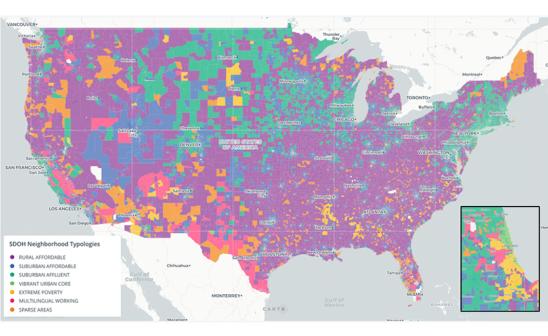New research published in JAMA Open explores how poverty, education, immigrant status and other social variables impact healthcare outcomes across the US

By Sarah Fister Gale
A cross-sectional study using census data to track multivariate social determinants of health measures that was coauthored by UChicago researcher Marynia Kolak has been published in the new issue of the Journal of the American Medical Association (JAMA) Open. The paper, entitled Quantification of Neighborhood-Level Social Determinants of Health in the Continental United States, is expected to help researchers and health professionals understand which combinations of social factors result in better or worse health results.
“Geographic data science approaches to public health are in demand and rapidly emerging as health professionals acknowledge the impact that community, poverty, mobility, and other place-based factors have on health,” says Kolak, who is assistant director for health informatics at the University of Chicago’s Center for Spatial Data Science and lead author of the paper.
Kolak is a health geographer who uses open-source science tools and spatial data science analytics to investigate health issues related to equity across space and time. She was formally trained in geographic information science and spatial statistics, and spent much of her early career in public health. She combined the two to focus on innovative applications in socio-spatial epidemiology, as she discovered that a place-based perspective can be particularly useful in understanding how the environment influences health outcomes.
Her UChicago team and co-authors at the Center for Health Innovation at the American Hospital Association looked at 71,901 census tracts for almost 312 million people across the US to identify neighborhood-level characteristics that impact health outcomes, and then measured associations between these “social determinants of health” and premature mortality in Chicago. The variables range from English language proficiency, to whether most residents have access to a vehicle or have a high rent burden.
Once the data was gathered, the research team used machine learning techniques to create multiple indices reflecting different dimensions of vulnerability that reflect neighborhood advantage, mobility, opportunity, and cohesion. They also characterized and mapped all tracts in the U.S. as distinct SDOH neighborhood typologies to facilitate comparisons, finding that ten percent of all tracts reflect a highly vulnerable group of “extreme poverty.”
Extreme poverty tracts were found in areas of known public health crises, from Flint, Michigan to the Navajo Nation. Using a multidimensional geospatial approach, they were able to underscore the complexity of underlying social determinants of health, and how combinations of variables can amplify impact.
For example, the vulnerability of areas with high poverty and low educational attainment (ie. neighborhood disadvantage) can be magnified if they are also composed of mostly elder and disabled residents, who may have unique mobility and access needs. Distinguishing these phenomena can help researchers better measure and understand their interactions.
The analysis shows that while factors like income, poverty, and health insurance status, play a significant role in health outcomes, there are many other nuanced factors at play, says Yoon Hong Park ‘19, who earned his master’s degree from UChicago’s Harris Public Policy at UChicago, is a coauthor on the paper, and is now a Data Fellow for the Cook County Government in Chicago.
Finally, the team estimated associations between premature mortality in Chicago using the SDOH indices they generated. Even after account for violent crime and regional differences in Chicago, the team found that over 65% of premature mortality in Chicago was associated with social determinants of health alone.
“We hope this research will help to enrich public policy for people with limited access to healthcare or other disadvantages,” says Park.
Health professionals have been aware that social factors impact patient health, however the specific reasons why have been difficult to quantify over time or at population scale, Kolak says. The research helps address this challenge by creating multiple Social Determinant Health Indices reflecting different dimensions of neighborhood vulnerability that looks beyond the three most commonly tracked social determinants of health – education, minority status and poverty – to understand how a confluence of determinants lead to different outcomes.
“We know that these factors are individually important to health outcomes for a number of different reasons,” she says. “We wanted to understand why they seem to matter more in some places than others.”
As a result of this work, some members of the team are now exploring the use of place-based insights to influence policy decisions, while others are exploring how to develop place-based interventions to ensure the right support is provided to the right patient groups at the right time. Kolak believes that when healthcare professionals can pinpoint the combination of social factors that positively or negatively affect healthcare outcomes, they will be better able to meet the needs of vulnerable populations with social policies and programs.
Kolak is especially excited to be included in JAMA Open, which is the American Medical Association’s flagship open source journal, meaning anyone can view its contents. “A lot of the code work we do is from free open source platforms, which makes the science more open, reproducible, and meaningful,” she says. “So being part of the open science paradigm through JAMA Open is exciting.”
“Having our work published by JAMA Open shows that people are paying attention to the various social factors that impact health status,” Park adds. “Seeing Dr. Kolak’s passion in pointing out health disparities in our society and making meaningful policy recommendations was a big part of my motivation for participating in this research.”
You can read the full paper in JAMA Open.
 THE UNIVERSITY OF CHICAGO
THE UNIVERSITY OF CHICAGO





